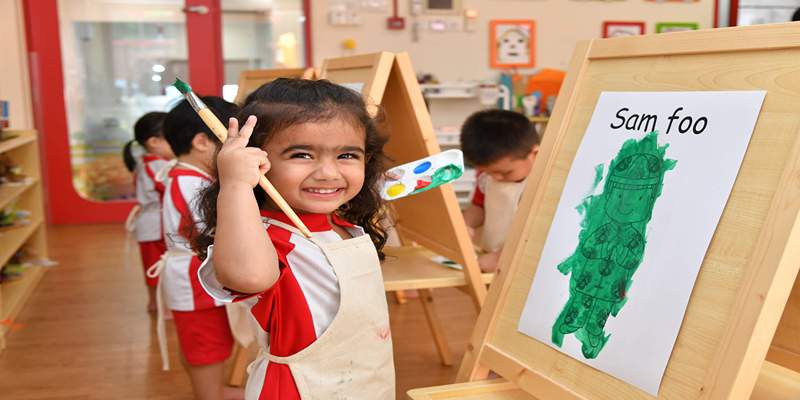Unlocking Creativity: How to Encourage Innovative Thinking in Children
Being creative isn't just for artists and musicians; it's an important life skill that has a big effect on a child's ability to change, solve problems, and come up with new ideas. Traditional education often focuses on memorizing and regulating tests, and it can miss every kid's unique potential.
Schools and parents can do a lot more than just teach kids facts. They can also help kids be creative and keep their natural interest and willingness to try new things. This blog discusses useful ways to encourage imagination, which can help kids become creative minds who come up with new ideas.
Why is Creativity Important?
Creativity is far more than artistic talent; it encompasses the ability to imagine new ideas, solve problems in novel ways, and adapt flexibly to changing circumstances. Creative children grow into adults who excel in diverse fields, from science and technology to business and entrepreneurship. They become individuals capable of pioneering solutions, overcoming challenges, and making significant societal contributions.
However, traditional educational practices emphasizing memorization and standardized testing can suppress creativity. The pressure to conform to rigid academic standards often diminishes a child's willingness to explore ideas freely. Therefore, actively nurturing creativity becomes essential in preserving and expanding this crucial skill.
Why Traditional Memorization Isn't Enough?
While memorization helps children recall facts quickly, it does little to promote critical thinking, problem-solving, or innovation. Memorization often leads to superficial learning, where children absorb information temporarily without truly understanding its context or relevance.
By contrast, creative learning encourages deeper engagement, critical questioning, and active exploration. It inspires children to build knowledge through inquiry and experimentation, enhancing long-term understanding and practical application.
Key Methods to Foster Creativity in Children

Nurturing creativity in children requires intentional effort and thoughtful strategies. By implementing various methods, parents and educators can significantly enhance a child's imaginative abilities and innovative thinking.
1. Encourage Open-Ended Questions
One effective way to nurture creativity is by encouraging open-ended questions. Instead of asking yes-or-no questions, pose queries that require deeper thought and allow multiple answers. Questions like, "What if?", "How might we...?" or "Why do you think...?" prompt children to explore possibilities, stimulating imaginative thinking and problem-solving abilities.
2. Provide Opportunities for Free Play
Creative play is vital for developing a child's imagination. Activities like storytelling, building, and imaginative role-play provide children with opportunities to invent, explore, and experiment. Allowing children unstructured playtime can significantly boost their creativity and innovation skills by encouraging them to develop unique ideas and solutions.
3. Embrace Mistakes and Learn from Failure
A critical aspect of nurturing creativity involves changing the perception of mistakes from negative to beneficial learning experiences. When children see mistakes as part of growth rather than failures, they become more willing to take risks and experiment creatively without fear. Encourage a growth mindset, teaching them that mistakes are stepping stones to learning and innovation.
4. Provide Diverse Experiences and Resources
Exposure to diverse environments and materials greatly enhances creativity. Introduce children to a range of books, technologies, cultural experiences, art supplies, and outdoor adventures. Such varied experiences stimulate curiosity and imagination, enabling kids to draw inspiration from different contexts and perspectives.
5. Promote Critical Thinking and Problem-Solving
Critical thinking and creativity are closely intertwined. Encourage children to think critically by challenging them to solve real-world problems. Presenting them with scenarios that require innovative solutions stimulates creative problem-solving, enabling them to apply creativity practically and confidently.
6. Foster Collaborative Projects
Collaboration helps children develop creative thinking by exchanging ideas and perspectives with peers. Group activities, team projects, and collaborative games provide valuable opportunities to learn creative cooperation, teamwork, and mutual inspiration.
7. Encourage Creative Expression through Arts
Artistic activities like drawing, painting, music, dance, and drama serve as powerful outlets for creative expression. Encourage children to experiment freely with these art forms without focusing solely on technical perfection. Creative arts enable emotional exploration, personal expression, and innovative thinking, significantly boosting overall creativity.
8. Offer Choices and Autonomy
Allowing children to make their own decisions nurtures independence and encourages creativity. Whether choosing a hobby, deciding on an art project, or picking their reading materials, giving children autonomy empowers them to think creatively and develop their unique voices and interests.
Creating a Creative Environment at Home and School

A supportive and inspiring environment significantly impacts a child's creative development. Here are some practical tips for fostering creativity in both home and educational settings:
- Encourage a Growth Mindset: Foster a growth mindset by praising effort and persistence rather than innate talent or intelligence alone. Highlight the value of perseverance and exploration in developing creativity.
- Provide Access to Resources: Ensure children have access to diverse creative materials, including books, art supplies, building blocks, and digital resources. These tools encourage experimentation and innovation.
- Model Creative Behavior: Adults should model creativity by openly engaging in creative pursuits, discussing ideas, and showing enthusiasm for innovation. Children are highly influenced by observing adults who value and demonstrate creativity.
Overcoming Challenges in Promoting Creativity
Despite recognizing creativity's value, certain challenges may hinder fostering creativity in children:
- Fear of Judgment: Many children hesitate to share their ideas due to fear of criticism or ridicule. Providing a safe, judgment-free environment where ideas are welcomed and valued helps children freely express themselves.
- Rigid Curriculums: Educational institutions heavily focused on standardized tests and structured curriculums might neglect creative subjects. Parents and educators should seek to balance structured learning with creative exploration opportunities.
- Limited Time: Overscheduling children's routines leaves little room for creative exploration. Allowing children adequate free time to play, imagine, and experiment is crucial for creative development.
Benefits of Fostering Creativity
Cultivating creativity has numerous long-term benefits, influencing personal, academic, and career success. Creative individuals:
- Exhibit stronger problem-solving skills and adaptability.
- Have enhanced emotional intelligence and resilience.
- Demonstrate improved academic and professional performance due to their innovative approaches.
- Contribute significantly to advancements in science, technology, business, arts, and societal progress.
Conclusion
Going beyond memorization by actively fostering creativity is essential for children's growth and success. Encouraging open-ended questioning, embracing failure, and providing diverse resources and supportive environments are just some of the ways to enhance creativity. Cultivating creativity empowers children to become innovators, capable of thriving in complex situations and contributing positively to society.
By emphasizing creativity, parents and educators play a vital role in shaping tomorrow's visionaries and innovators. Children equipped with these essential skills are not only poised for personal success but also contribute to creating a more adaptable, innovative, and prosperous future for all.












